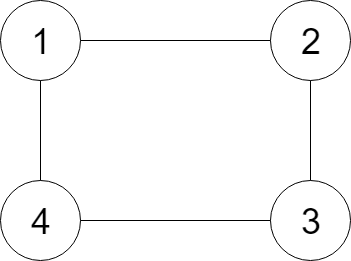您好,登錄后才能下訂單哦!
您好,登錄后才能下訂單哦!
這期內容當中小編將會給大家帶來有關C++中怎么利用LeetCode克隆無向圖,文章內容豐富且以專業的角度為大家分析和敘述,閱讀完這篇文章希望大家可以有所收獲。
Given a reference of a node in a connected undirected graph, return a deep copy (clone) of the graph. Each node in the graph contains a val (int) and a list (List[Node]) of its neighbors.
Example:

Input:
{"$id":"1","neighbors":[{"$id":"2","neighbors":[{"$ref":"1"},{"$id":"3","neighbors":[{"$ref":"2"},{"$id":"4","neighbors":[{"$ref":"3"},{"$ref":"1"}],"val":4}],"val":3}],"val":2},{"$ref":"4"}],"val":1}
Explanation:
Node 1's value is 1, and it has two neighbors: Node 2 and 4.
Node 2's value is 2, and it has two neighbors: Node 1 and 3.
Node 3's value is 3, and it has two neighbors: Node 2 and 4.
Node 4's value is 4, and it has two neighbors: Node 1 and 3.
Note:
The number of nodes will be between 1 and 100.
The undirected graph is a simple graph, which means no repeated edges and no self-loops in the graph.
Since the graph is undirected, if node p has node q as neighbor, then node q must have node p as neighbor too.
You must return the copy of the given node as a reference to the cloned graph.
這道無向圖的復制問題和之前的 Copy List with Random Pointer 有些類似,那道題的難點是如何處理每個結點的隨機指針,這道題目的難點在于如何處理每個結點的 neighbors,由于在深度拷貝每一個結點后,還要將其所有 neighbors 放到一個 vector 中,而如何避免重復拷貝呢?這道題好就好在所有結點值不同,所以我們可以使用 HashMap 來對應原圖中的結點和新生成的克隆圖中的結點。對于圖的遍歷的兩大基本方法是深度優先搜索 DFS 和廣度優先搜索 BFS,這里我們先使用深度優先搜索DFS來解答此題,在遞歸函數中,首先判空,然后再看當前的結點是否已經被克隆過了,若在 HashMap 中存在,則直接返回其映射結點。否則就克隆當前結點,并在 HashMap 中建立映射,然后遍歷當前結點的所有 neihbor 結點,調用遞歸函數并且加到克隆結點的 neighbors 數組中即可,代碼如下:
解法一:
class Solution {
public:
Node* cloneGraph(Node* node) {
unordered_map<Node*, Node*> m;
return helper(node, m);
}
Node* helper(Node* node, unordered_map<Node*, Node*>& m) {
if (!node) return NULL;
if (m.count(node)) return m[node];
Node *clone = new Node(node->val);
m[node] = clone;
for (Node *neighbor : node->neighbors) {
clone->neighbors.push_back(helper(neighbor, m));
}
return clone;
}
};我們也可以使用 BFS 來遍歷圖,使用隊列 queue 進行輔助,還是需要一個 HashMap 來建立原圖結點和克隆結點之間的映射。先克隆當前結點,然后建立映射,并加入 queue 中,進行 while 循環。在循環中,取出隊首結點,遍歷其所有 neighbor 結點,若不在 HashMap 中,我們根據 neigbor 結點值克隆一個新 neighbor 結點,建立映射,并且排入 queue 中。然后將 neighbor 結點在 HashMap 中的映射結點加入到克隆結點的 neighbors 數組中即可,參見代碼如下:
解法二:
class Solution {
public:
Node* cloneGraph(Node* node) {
if (!node) return NULL;
unordered_map<Node*, Node*> m;
queue<Node*> q{{node}};
Node *clone = new Node(node->val);
m[node] = clone;
while (!q.empty()) {
Node *t = q.front(); q.pop();
for (Node *neighbor : t->neighbors) {
if (!m.count(neighbor)) {
m[neighbor] = new Node(neighbor->val);
q.push(neighbor);
}
m[t]->neighbors.push_back(m[neighbor]);
}
}
return clone;
}
};上述就是小編為大家分享的C++中怎么利用LeetCode克隆無向圖了,如果剛好有類似的疑惑,不妨參照上述分析進行理解。如果想知道更多相關知識,歡迎關注億速云行業資訊頻道。
免責聲明:本站發布的內容(圖片、視頻和文字)以原創、轉載和分享為主,文章觀點不代表本網站立場,如果涉及侵權請聯系站長郵箱:is@yisu.com進行舉報,并提供相關證據,一經查實,將立刻刪除涉嫌侵權內容。